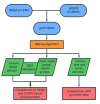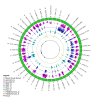Genomic characterization of clinically significant blood group variants in Aboriginal Australians
- PMID: 38557323
- PMCID: PMC11576151
- DOI: 10.2450/BloodTransfus.664
Genomic characterization of clinically significant blood group variants in Aboriginal Australians
Abstract
Background: Hematological disorders are often treated with blood transfusions. Many blood group antigens and variants are population-specific, and for patients with rare blood types, extensive donor screening is required to find suitable matches for transfusion. There is a scarcity of knowledge regarding blood group variants in Aboriginal Australian populations, despite a higher need for transfusion due to the higher prevalence of renal diseases and anemia.
Materials and methods: In this study, we applied next-generation sequencing and analysis to 245 samples obtained from Aboriginal Australians from South-East Queensland, to predict antigen phenotypes for 36 blood group systems.
Results: We report potential weak antigens in blood group systems RH, FY and JR that have potential clinical implications in transfusion and pregnancy settings. These include partial DIII type 4, weak D type 33, and Del RHD (IVS2-2delA). The rare Rh phenotypes D+ C+ E+ c- e+ and D+ C+ E+ c+ e- were also detected.
Discussion: The comprehensive analyses of blood group genetic variant profiles identified in this study will provide insight and an opportunity to improve Aboriginal health by aiding in the identification of appropriate blood products for population-specific transfusion needs.
Conflict of interest statement
The Authors declare no conflicts of interest.
Figures


Similar articles
-
Increasing access to screening for blood-borne viruses and sexually transmissible infections for Aboriginal and Torres Strait Islander Australians: evaluation of the Deadly Liver Mob program's 'cascade of care' across nine sites in New South Wales, Australia.Harm Reduct J. 2023 Sep 5;20(1):125. doi: 10.1186/s12954-023-00850-6. Harm Reduct J. 2023. PMID: 37670361 Free PMC article.
-
Data analysis of zoonoses notifications in Aboriginal and Torres Strait Islander populations in Australia 1996-2021: implications for One Health.Front Public Health. 2023 Oct 12;11:1175835. doi: 10.3389/fpubh.2023.1175835. eCollection 2023. Front Public Health. 2023. PMID: 37900024 Free PMC article.
-
Can flash glucose monitoring improve glucose management for Aboriginal and Torres Strait Islander peoples with type 2 diabetes? A protocol for a randomised controlled trial.Trials. 2024 Jul 19;25(1):493. doi: 10.1186/s13063-024-08267-7. Trials. 2024. PMID: 39030640 Free PMC article.
-
Systemic lupus erythematosus in Aboriginal and Torres Strait Islander peoples in Australia: addressing disparities and barriers to optimising patient care.Lancet Rheumatol. 2024 Oct;6(10):e713-e726. doi: 10.1016/S2665-9913(24)00095-X. Epub 2024 Jul 3. Lancet Rheumatol. 2024. PMID: 38971169 Review.
-
The 'ABC' of respiratory disorders among adult Indigenous people: asthma, bronchiectasis and COPD among Aboriginal Australians - a systematic review.BMJ Open Respir Res. 2023 Jul;10(1):e001738. doi: 10.1136/bmjresp-2023-001738. BMJ Open Respir Res. 2023. PMID: 37451702 Free PMC article.
References
-
- Majoni SW, Lawton PD, Rathnayake G, Barzi F, Hughes JT, Cass A. Narrative review of hyperferritinemia, iron deficiency, and the challenges of managing anemia in Aboriginal and Torres Strait Islander Australians with CKD. Kidney Int Rep. 2020;6:501–512. doi: 10.1016/j.ekir.2020.10.035. - DOI - PMC - PubMed
MeSH terms
Substances
LinkOut - more resources
Full Text Sources
